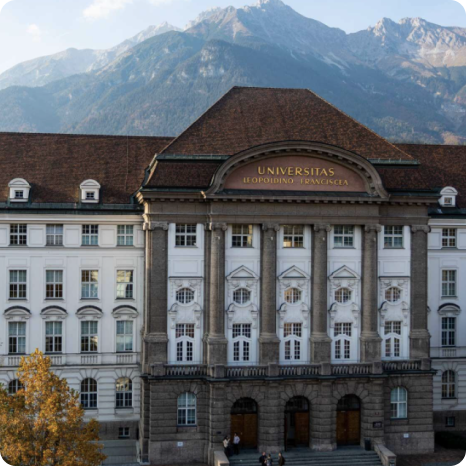Safe, inclusive communications for the University of Innsbruck
The open Matrix network is the foundation for secure, collaborative academic research and learning.

The open Matrix network is the foundation for secure, collaborative academic research and learning.

The University of Innsbruck is one of Austria’s largest universities. Founded in 1669, it has 16 faculties offering a broad range of subjects to almost 30,000 students.
Keen to support its vibrant learning culture, the university wanted to introduce a real time messaging system. “Email was proving slow and cumbersome, particularly for those operating from smartphones and tablets. Meanwhile unmanaged consumer-grade messaging apps created a fractured community, spread across siloed apps, and risked sensitive data,” says Katharina Köhle, Project Manager, IT Services.
So in 2020 the University of Innsbruck embarked on an initiative to create a university-wide real time communications platform. Katharina Köhle, continues: “Just weeks later the pandemic struck, our 12 month project suddenly became a five month sprint.”

Promote vibrant learning culture
Project accelerated due to COVID
Support for 35,000 staff and students

With no preconceptions of the eventual solution, the University of Innsbruck set the parameters of its search. Conscious of its security, compliance and safeguarding responsibilities the university had a strong preference for an on-premise messaging platform. This instantly avoided the issues of having staff and students personal data - and their discussions - being sucked into third party servers.
To further maintain its independence, the University of Innsbruck was also hopeful of finding a suitable open source solution. As a public institution, entrusted with public money, it prefers to invest in open source as that, in turn, contributes to other public sector projects.
“Open source, and open standards, is more sustainable as it helps guard against vendor lock-in,” says Matthias Weiler, Systems Engineer, IT Services. “We have competent and adventurous people who can develop on top of what’s already available. The scientific community shares a lot of values with the Free Software Community.”
Given the collegiate nature of academia, the chosen system would ideally support connectivity across the university’s broad, loosely affiliated partners and communities too.
However, with the impact of COVID-19 increasingly evident and timeframes compressed, it was no time for idealistic choices or risk taking. Not only did it have to be a mature solution capable of supporting more than 5,000 staff and almost 30,000 students - and the wider community - but also one that was already proven in the education sector.
After a thorough examination of all options, the eventual choice was between Rocket.Chat and Matrix-based Element.
“In the end it was a very clear choice. Matrix gave us the federation we needed. It’s an open network, so it makes connectivity really straight-forward; both internally and externally.”
Matthias Weiler, Systems Engineer, IT Services
Matthias Weiler continues: “Our on-premise system would immediately be compatible with anything else Matrix-based. That means all our staff, students and outside partners can easily and securely connect at zero cost. We also saw strong adoption of Matrix throughout German-speaking universities and research institutes.”
Having wrestled with the initial impact of COVID, the University of Innsbruck was determined to have its real time communications platform - named Chat internally - in place for the beginning of the new academic year. Whether 35,000 staff and students would be buzzing around the university’s alpine campuses, or locked-down at homes around the world, there was no doubt that the university’s Chat platform would be absolutely crucial.
Having chosen Element at the end of June, that left just over three months to deploy the whole system in time for the new term starting 15 October. “It was a tight timeframe, but the implementation was pretty smooth,” recalls Matthias Weiler. “Deploying Synapse was easy enough; one package, one upload. Integrating the Video Chat System, Jitsi Meet, was also straight-forward. We got Element to enhance the SAML authentication for Single Sign On, and that’s now available as open source. We’re pleased to have contributed back to the community.”
Chat went live, as planned, on 15 October. From desktops and laptops, Chat is accessed through a web browser using a University of Innsbruck domain. The standard Element app, available from the usual app stores, is recommended for access from smartphones and tablets.
Although, of course, people are able to create any Matrix-based ID and participate in public rooms, the university stipulates that staff and students create a formal University of Innsbruck Matrix ID based on its email address format.
“We’ve let staff and students find their own way of using Chat. We wanted them to have the freedom to mould it; to enable new ways of teaching, and new ways of working together with outside parties.”
Katharina Köhle, Project Manager, IT Services.
Element is used as the chat channel during live streamed lectures; a usage that is likely to stay even when lectures return to their pre-pandemic normal.
Outside of specific lectures, there are around 35 public rooms that replicate the classroom environment of a lecturer and their students (typically around 450 students) discussing topics.
The broadest use of Chat is the wide range of chat rooms created and used by students, and that typically includes people from outside of the student body itself.
“We created Chat to empower students to create their own groups and discussions, whether that’s specifically for studies, interest-based clubs or just general community and friendship groups,” Katharina Köhle explains. “It gives them an instant way to connect and discuss to help their learning. We’re seeing people make good use of various widgets within chat rooms; from simple plug-in functionality to data feeds that help modelling and learning.”
Chat is also used as a 1:1 channel between students and academic staff. “Our staff members have made great use of it, to simply discuss and coordinate the day-to-day,” reveals Katharina Köhle.
With WiFi available across the entire university, Matrix-based Chat also gives staff and students free telephony. “The in-app audio and video are great; crystal clear,” adds Matthias Weiler.
By hosting its own real time communication platform, University of Innsbruck automatically benefits from keeping its users’ data safe.
Unlike traditional proprietary apps, such as Slack, MS Teams and WhatsApp, data is not sucked into a centralised system operating from US-based servers. There is no datamining, and no danger of personal data being lost should a centralised server be breached.
Innsbruck’s criteria at a glance
Element
MS Teams
Slack
Federation, open network
Open source
On-premise, data sovereignty
End-to-end encryption
Comparison of Element and the Matrix protocol against MS Teams and Slack
“It also helps us be GDPR compliant, because we retain ownership and control of our messaging,” says Katharina Köhle.
Chat has been deployed without the default end-to-end encryption (E2EE) available within Matrix. The users can easily make a room end-to-end encrypted, and of course they can switch their own conversation to E2EE if they wish.
“Operating without E2EE keeps the creation and management of rooms really simple,” explains Matthias Weiler. “But for sensitive topics - say discussion around as yet unpublished scientific research data - people are able to switch E2EE on. So everything is further protected by E2EE if end-users feel it’s necessary. The advantage of E2EE for us, as the server operator, is that we have less personal data on our systems that we need to manage and protect. Data Minimisation, as mandated by the GDPR, means treating personal or sensitive data like toxic waste; to avoid it where possible.”
The combination of Element and Matrix was chosen to create Chat as a result of the open Matrix network to aid easy connectivity between people. As Matthias Weiler looks to the future, Matrix’s open approach is crucial:
“We very much imagine taking advantage of Matrix APIs for integration with Learning Management Systems and in particular
OpenOLAT
.
“We also see widgets as a really powerful way to enhance shared learning, whether that’s in lectures or research and discussion groups. There’s also more we can explore with video chat and streaming, collaboration and joint working.”
Katharina Köhle, Project Manager, IT Services.
Katharina Köhle also points to the role that staff and students can play, now that they have an open and secure communication platform:
“We’ll see how the use of Chat grows, and how people adopt it in different ways. But with Matrix already popular across German-speaking universities, we’re incredibly keen to see both staff and students participating with their peers outside of the university itself. And with almost half our students being international, the global reach of Matrix means we can quite literally take our learning right around the world. We’ve been able to internationalise in real time.”
University of Innsbruck is one of many universities in the DACH region that has adopted Matrix-based messaging. The Matrix protocol is supporting the development of a vibrant community across German-speaking universities. Being open source multiple universities, research institutes and individuals are able to freely communicate and share resources.
Learn More

Matrix is an open network for secure, decentralised communication, connecting 80M+ users over 80K+ deployments.